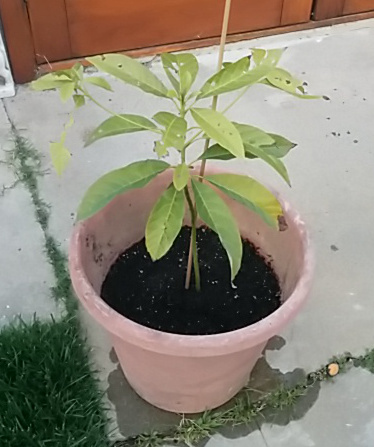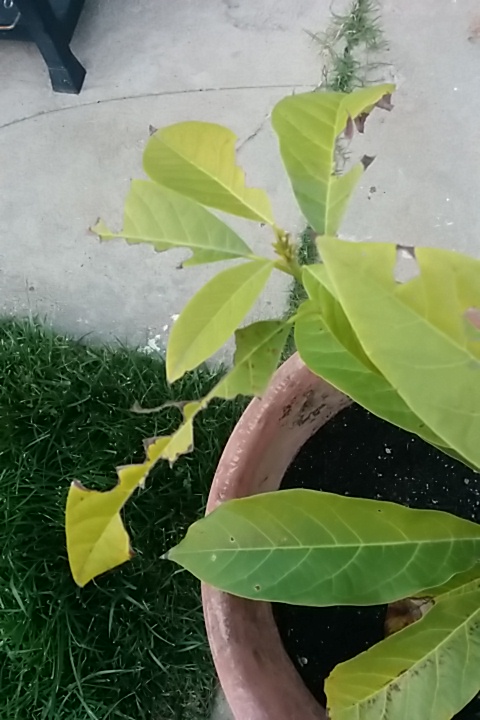Some time ago Taylor grew an avocado tree from a seed she got from a grocery store avocado. Apparently a grocery store avocado can sometimes grow into a plant if the seed is split. Taylor heard this and when she found one she grew a healthy little tree which she deposited in my care after going to MIT. Of course I have a black thumb and so now the plant is in bad shape. Just like Taylor it needs some rehab.
My girlfriend Inge, who is a farmer’s daughter and has a green thumb, replanted it with healthy soil but it still looks kind of sickly.
 Something is eating this plant. Does anyone have an idea what is eating the leaves and making them look so sickly? Does anyone know how to get rid of it?
Something is eating this plant. Does anyone have an idea what is eating the leaves and making them look so sickly? Does anyone know how to get rid of it?
Climate wise, the plant is in Los Angeles, Venice Beach to be exact. This is a challenge to all you southern California gardeners out there.


Did you ever find out what was ailing the plant?
Its caterpillar damage, just keep looking under the leaves every once in a while and if you spot one pick it off (really no need to us those nasty bug chemicals…)
beyond that maybe a bit of organic fertilizer and don’t over water it . Its pretty easy to drown plants with love……….
Cheers!
That doesn’t look like snail damage to me, personally. If it was, you would probably notice some slime somewhere on the leaves/soil/pot/concrete and the snails would probably be nearby. Have you tried looking up avocado-specific pests? Here is a site I found: http://www.ipm.ucdavis.edu/PMG/selectnewpest.avocado.html
It also mentions a few common “run of the mill” pests, so that might give you some ideas. I think it’s noteworthy that most of the damage seems to be on the upper, newer leaves. That might narrow down your culprit.
Rhonda’s message today: What a lovely, positive way of looking at a caterpillar enjoying a few of Taylor’s avocado leaves and then growing into a beautiful butterfly, a metaphor for Taylor’s healing. A caterpillar it is, and Taylor is perfect.
Love,
Nina
My thought is a caterpillar has gotten to the tree. It looks just like some of my plants that have become banquets lately. And if this is the case it’s a wonderful metaphor for us to keep in mind as Taylor is healing. The caterpillar will soon become a beautiful butterfly.
Good morning! Sure enough-I remembered the damage to my agaves in front of my house: Sleep and dreams also moved my thinking about the avocado leaf damage more towards a big grasshopper. Has anyone seen a grasshopper lurking around, looking hungry? We’ll get to the bottom of all this-not to worry.
Taylor and Kit and Dad John-my thoughts and wishes for comfort on today’s trip! and in everything new in Colorado. Go West young woman!
Love,
Nina
What a beautifully shaped little avocado tree! The Sunset Western Garden Book says, “The all-important factor in growing avocados is good drainage (For trees out in the groves and gardens) high water table in winter rainy season is often fatal, even in well-drained soils.” (Again about fully grown trees outdoors:) “Most roots are in top 2 ft. of soil, so water lightly and frequently enough to keep that layer moist but not wet (fast drainage is important).” (About the trees outdoors:) “Give heavy irrigation every third of fourth time to wash out any excess accumulated salts. This will minimize salt burn. Fertilize lightly. Control chlorosis (Nina: yellowing of leaves) with iron sulfate or iron chelate.” I do not think this little young plant needs this much chemical treatment at this time. But I could be wrong.
The sensitivity to over-watering struck me right away when I saw the pictures. Right under the pot, water has seeped out, perhaps right after transplantation. Nice touch with the stick for support.
Now the question: Who nibbles, or rather chomps away at the perfect leaves?
Lotta nerve! To me it looks a lot like what snails did to plants of mine. Maybe I’ll remember in the morning which plants that was. And I’ll ask “my” Armstrong Nursery-person to morrow with the excellent photos. Nite-nite, Nina
P.S. Taylor, what a great job you did in raising this lovely plant!
I reached out to a LA County Cooperative Extension Master Gardener I know, who replied with what she knew AND forwarded the question to an Orchard
Here are their answers. First, from Sarah the gardener:
“Katie, I don’t know enough about avocados or trees to be of help. But it’s a pest eating those leaves. We just don’t know what that pest is. They could try putting horticultural or neem oil on the leaves, wash them with soap and water.
But here’s the really bad news: when you sprout an avocado seed, especially one that comes from a grocery store, you don’t know what you’re getting. You don’t know if it was a hybrid to begin with which means it won’t grow true to the original; it might become one or the other of the traits that were used to create the hybrid. Only heirloom open pollinated plants will grow true from seed.
I wish I could give you more hope. I will cc the only tree pro that I know, who is also our MG tree expert, Herb M*****. Maybe he’ll know more just from looking at this or might have some better advice for you.
It’s a sad situation, and I am so sympathetic to the parents. I wish I could offer you more.”
And from Herb, the orchard expert:
“Sarah is exactly right, and I would only make a few added suggestions:
The little tree looks healthy, without disease, but it appears that the leaves are being eaten by an insect. Could be a leafhopper, or a leaf cutting wasp, or even a snail that has found its way into the pot.
At night, or early in the morning, take a flashlight and look at the underside of the leaves. You’ll very likely see the insect or snail. Describe what you find and I’ll give you some suggestions on how to get rid of it. Or take it in to a local Nursery, and they can choose an appropriate insecticide.
You probably should feed the little tree, to get some more vigorous growth and make it more resistant to the bugs. Buy a little bottle of fish emulsion, or liquid “container plant food.” and follow the instructions.
When the tree gets a bit bigger we could “graft” a twig from a producing Avocado Tree onto your tree, and the new branch will insure that you get edible fruit.
The best time to do the graft is when the little tree reaches 25 to 30 inches tall.
Let me know when that happens, and I’ll tell you how to do it, and can get a good twig for you to graft.
Although you’re having a bit of a problem, this can certainly turn into a very nice Avocado tree with very good fruit.
Herb
Master Gardener Orchard Team”
I didn’t feel comfortable posting Herb’s contact information on this site, but I have Kit’s email address and will send it to her. You can find Sarah at the Mar Vista Farmer’s Market once a month at the gardeners’ table at the intersection, if you want to say “hi” or thank her for her help.
I’ve read about Taylor’s first day of rehab at Craig and am so impressed. You have an awesome, determined daughter and a great rehab team. I look forward to hearing of her continued progress.
Wow ! What a great bunch of replys. All your advice is greatly appreciated.
Because of travel to Denver, the tree is currently alone in Venice for the next 3-4 weeks. I will ask Kit to see if anyone at the UU church wants to take on the tree as a rehab patient and try some of this advice.